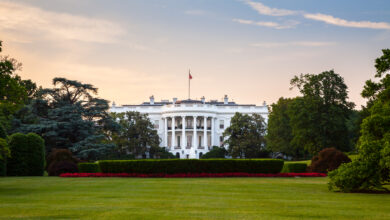Blundering to another war in the Gulf?

For almost forty years the United States has been in a state of war in the Persian Gulf. American forces battled the Iranian navy, and destroyed Iranian oil installations in the 1980’s, fought Iraqi forces to evict them from Kuwait in 1991, bombed Iraqi targets over the next decade and in March 2003 invaded Iraq beginning the second longest war in American history. A brief withdrawal in 2011, was followed in 2014 by a massive air campaign against the ’Islamic State’ that occupied large swaths of Iraqi and Syrian territories. Only in recent months U.S Special Forces working with local allies defeated ISIS as an organized fighting force in both countries. Today, American forces in Syria, Iraq, Kuwait, Bahrain, Qatar and the United Arab Emirates are on high alert, amid rising tension with Iran, with additional U.S. air and naval assets arriving into the region. Once again the U.S. finds itself caught in another cycle of confrontation in the Gulf. What seems like America’s endless wars and woes in the Gulf region should not be allowed to go on in a breathtaking regularity and an air of inevitability as if the whole area is a huge stage for a Modern Greek tragedy; where we know that the outcome is preordained, but we are unable to stop the inevitable.
Neither the Trump Administration, nor the Iranian regime is seeking war. But we may be slouching towards another bloody conflict by chance or maybe by design, if the hardliners beating the drums of war in the U.S, Iran, Israel and Saudi Arabia have their way. Candidate Trump campaigned against the wars his predecessors began and continued in the Middle East and South Asia. As president, he repeatedly displayed his instinct to disengage militarily from those conflicts. However, his decision to withdraw from The Joint Comprehensive Plan of Action (JCPOA), and the re-imposition of comprehensive sanctions on Iran including secondary sanctions on allied countries buying Iranian oil and gas was the equivalent of throwing the gauntlet in the face of the Iranian regime. The appointment of John Bolton, an unabashed proponent of regime change in Iran as National Security Advisor, and Mike Pompeo, a proud Christian Crusader awaiting the Rapture and a harsh critic of the Islamic regime, as Secretary of State, brought two Iagos very close to the President’s ears. The question now is whether these powerful hardliners in Washington and their allies in the Middle East will become the new Sirens that could lure the obtuse Donald Trump to another war in the Gulf.
The ascension to power in Saudi Arabia of the impetuous Crown Prince Mohammed Bin Salman, who in 2015 led a coalition of Arab states into a disastrous military campaign to defeat the Iranian army and trained Houthi rebels in Yemen, turned the two claimant leaders of the Muslim world from adversaries into open enemies. After four years of fighting in which the Saudi Air Force repeatedly bombed civilian targets, killing thousands of civilians and causing the worst humanitarian crisis in the 21st century, the fighting has settled into a grinding war of attrition. The intermediate range missiles and drones that Iran supplied the Houthis have allowed the Yemeni rebels to rattle and embarrass the Saudi leaders who cannot stop the indiscriminate firing of these missiles deep into the kingdom. Increasingly, for the Saudis and the Emiratis living in the shadow of an ascendant, an occasionally belligerent Iran has become intolerable.
For many years, Israel’s Prime Minister Benjamin Netanyahu, has been warning the United States and the world that Iran, given its political and ideological hostility towards Israel, its growing missile arsenal, regional ambitions and readiness to deploy effectively its powerful proxies in military conflicts such as the war in Syria, constitutes an existential threat. Hence Israel’s uncompromising rejection of even a peaceful nuclear program in Iran. Netanyahu’s stormy relations with former President Barack Obama was over their different approaches to Iran in as much as it was over their conflicting views on the nature of peace between Palestinians and Israelis. Netanyahu’s opposition to the JCPOA was loud and strong. Saudi-Emirati opposition was initially quiet, and then muted after Obama implicitly supported their war in Yemen. Obama’s flawed approach to Iran went beyond the inherent limitations of the JCPOA. In fact one can accept the agreement as imposing temporary but significant delays on Iran’s nuclear ambitions. By not insisting on serious limitations on Iran’s missile program, the Obama administration exposed itself to legitimate criticism from those who were willing to live with a contained Iran. However, the Obama administration was most egregious in its abject failure in deterring Iran’s destructive regional rampages and in checking Iran’s open challenge to America’s interests and the interests of its regional allies from Lebanon to Syria, and from Iraq to Yemen.
The Israelis and the Saudis, who could not hide their contempt for Obama’s passive approach to Iran, saw in the election of Trump, who railed incessantly against Iran and the JCPOA during the campaign, a vindication of their hardline posture towards Tehran. Now, their new friend in the White House could lead the charge against their common enemy and relieves them from a burden too colossal for them to undertake. The Saudis and the Israelis would like to see the United States deliver a crushing blow to Iran’s military and to destroy what’s left of its nuclear infrastructure and to cut down Iran’s regional ambitions. The enmity towards the Iranian regime shared by Israelis, Saudis and Emiratis led to increased political cooperation and intelligence sharing in recent years. One could see them making the case for a major U.S. move against Iran, to shake the foundations of the Islamic regime, even if a limited attack – assuming the Iranian reaction will also remain limited- leaves the regime in place, but reeling and in retreat.
One war giving birth to another
The fact that we are talking about a potential new war when we are still coping with the daemons of a war that is not fully over yet, certainly not for those who are still deployed in Iraq and the thousands who were severely scarred physically and emotionally, should give us pause to reflect on that hinge moment in history that brought us to invade Iraq, and maybe go to war with Iran. On September 22nd, 1980, Saddam Hussein ordered his armed forces to invade Iran, a country three times the size of Iraq, thus beginning the longest conventional war in the 20th century. There is a long trail of blood connecting Iraq’s invasion of Iran, with its invasion of Kuwait a decade later, and the second Gulf war to liberate Kuwait in 1991, which put the U.S. on the long road to the invasion of Iraq, and may keep it on track to go to war with Iran in the future. This is a tragic tale of one war giving birth to another, and another…
When Iraq invaded Iran, its reserves of foreign currencies were around $36 billion. Eight years later, Baghdad owed Western banks and the Gulf Arab states nearly a $100 billion. When Kuwait refused to relieve Iraq of repaying its $14 billion debt, Saddam carried out the biggest bank heist in modern times. The invasion of Kuwait was the epilogue to the Iraq-Iran war. The Gulf War that liberated Kuwait ended with an ambiguous and inconclusive cease-fire in February 1991. Saddam Hussein’s brutal response to the twin armed uprisings of the Shia and the Kurds led the United States, the United Kingdom and France to impose two no fly zones to protect the Kurds in the north and the Shia in the south from Saddam’s air force. In the years that followed, the U.S and the UK launched a low-intensity air campaign against Iraqi air defense systems and other military targets and the NFZs were used to put pressure of the Iraqi regime to comply with United Nations Security Council resolutions related to the work of the international inspectors looking for Weapons of Mass Destruction activities. A major flare-up occurred in December 1998 when the Clinton administration launched Operation Desert Fox, an intense 4 day bombing campaign with British support against military targets and facilities suspected of developing WMD. By the end of the 1990’s the U.S. had flown over 200,000 sorties over Iraq, according to the Defense Department. The NFZs which began in 1992 officially ended when the American forces stormed the Iraqi borders from Kuwait on their way to Baghdad on March 20th, 2003 in search of non-existing weapons of mass destruction to eliminate, and, the equally non-existing Jeffersonian democrats to install on the banks of the Tigris River. One war creating another.
The fall of Baghdad was a pyrrhic victory, for it signaled the beginning of a protracted series of American military fights, first against the remnants of the Ba’athi regime, then al Qaeda terrorists before their metamorphosis into the most lethal and effective Jihadist group in modern times; The Islamic State and its Caliphate straddling both Iraq and Syria. The invasion of Iraq which ended the Arab Sunni domination of the Iraqi state and emboldened the Shi’a plurality contributed mightily to the deepening tension between the two sects. Sectarianism in the new Iraqi state has been codified with American acquiesce. The modern Sunni-Shia polarization is not a function of ancient hatreds “rooted in conflicts that date back millennia,” as President Barack Obama, infamously claimed, but rather a function of the struggle among the states of the region seeking economic, military and political hegemony. Whipping up and exaggerating sectarian grievances and elevating them to existential threats has proven to be an effective tool of mobilizing the foot soldiers by the cynical political and religious leaderships of both sects claiming to defend the sacred, in order to safeguard the earthly gains of the elites.
Iraq’s weak cohesion and its already brittle unity may have suffered irretrievable damage after a savage civil war, followed by the depredations of the Islamic State which in turn deepened the sectarian/political fissures, and allowed Iran to become the outside power with the most political, cultural and security influence in Iraq. The demise of Iraq as a regional power, that checked Iran at a great cost, enhanced the ascendency of a more belligerent and emboldened Iran that is bent on challenging and limiting the influence of the United States in the Levant, the Gulf region and in South Asia. Iran is wielding a greater influence through its Shia foreign legions, some of them notoriously well-known like the Lebanese Hezbollah, and some of the Iraqi Popular Mobilization Units, others less so, in a region that stretches from Pakistan on the Indian Ocean to Lebanon on the Mediterranean.
In recent years, Iran has built up strong proxy forces in Iraq, Lebanon, Syria and Yemen composed mainly of Shia adherents. Iran armed these groups, particularly Hezbollah in Lebanon with thousands of medium range missiles, making them an integral part of its strategic deterrence. If Iran finds itself subjected to a major U.S. air and naval assault, (an invasion of Iran is unthinkable) supported logistically by Israel and Arab Gulf states, it can be expected to unleash its regional proxies, and turn the battle into a destructive region-wide conflict. In such a conflict the U.S. will find itself without its NATO allies. The repressive Iranian regime is widely resented, and Iran’s economy is reeling from the impact of U.S sanctions, but the regime is very likely to survive even a massive U.S. attack. The United States has plenty of military options against Iran, but fundamentally America’s problems with the Iranian regime are not amenable to a military solution.
Iran’s growing influence in the region is in part a function of the law of unintended consequences; a.k.a America’s defeat of Iran’s enemies in Afghanistan and Iraq. With the Trump administration’s ratcheting up its economic and military pressure on Iran, which could lead Tehran to resume its nuclear research and development program, the potential for serious military flare-ups involving the U.S. and Iranian forces in the waters of the Gulf, or U.S. forces operating in Iraq and Syria with Iran’s proxies has increased exponentially. Once again, the United States and Iran could find themselves on a collision course, that was preordained on that fateful and distant day in September 1980 when one war gave birth to another, and another…
===============================================================
Hisham Melhem is a columnist for the Lebanese daily Annahar, and a non-resident fellow at the Arab Gulf States Institute in Washington. Follow him on Twitter at: @hisham_melhem.




